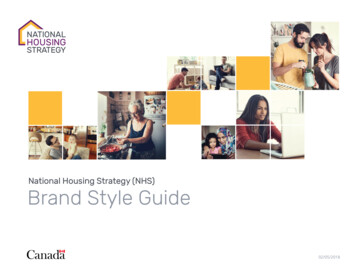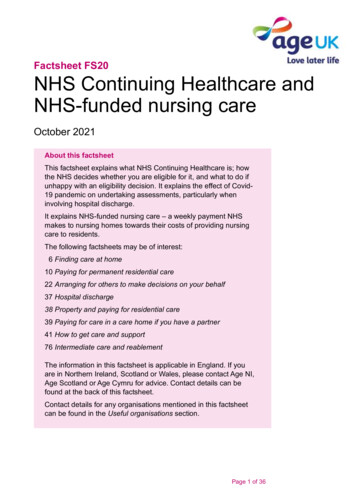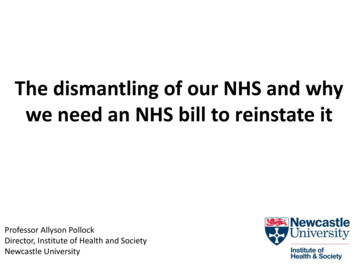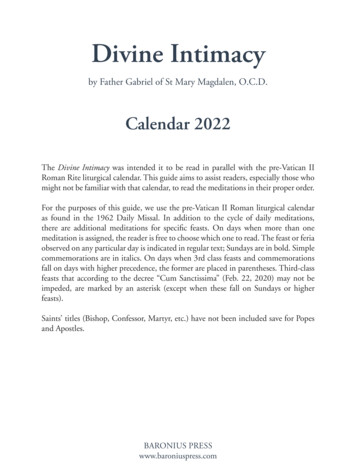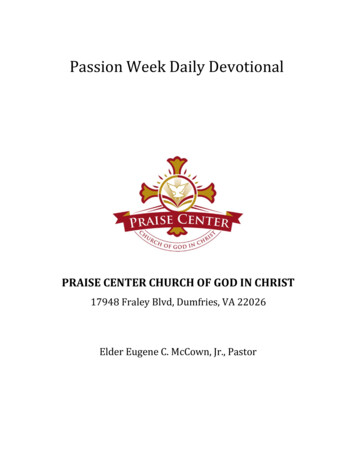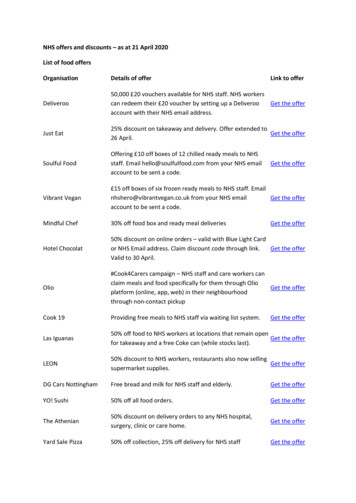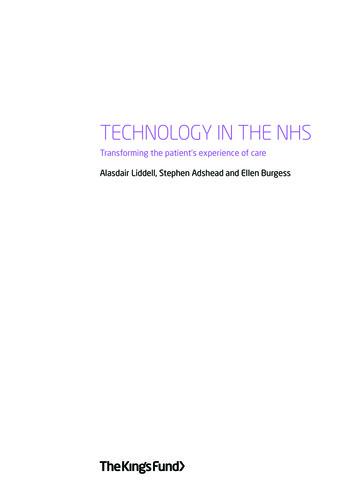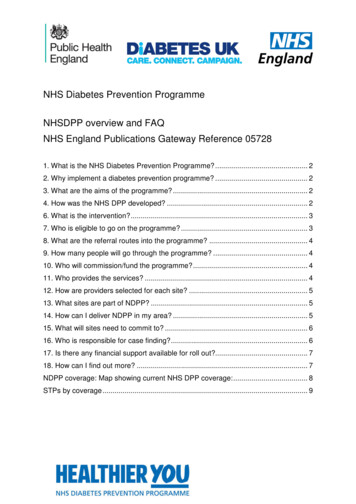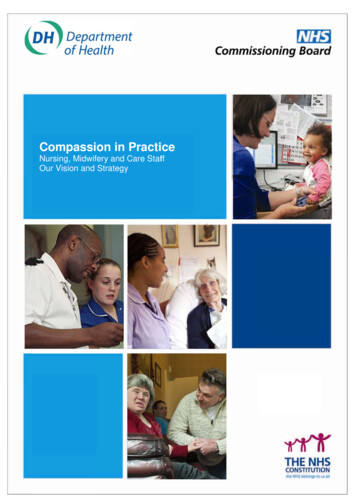
Transcription
\mpassion in PractiiceComNursingg, Midwiffery and CareCStafffOur Vission and Strategy1
DH INFORMATION READER BOXPolicyHR / WorkforceManagementPlanning / PerformanceClinicalCommissioner DevelopmentProvider DevelopmentImprovement and EfficiencyDocument PurposePolicyGateway Reference18479TitleEstatesIM & TFinanceSocial Care / Partnership WorkingCompassion in PracticeAuthorCommissioning Board Chief Nursing Officer and DH Chief NursingAdviserPublication Date4 December 2012Target AudiencePCT Cluster CEs, NHS Trust CEs, Care Trust CEs, Foundation TrustCEs , Directors of PH, Directors of Nursing, Directors of Adult SSs,Directors of HR, Directors of Children's SSsCirculation List#VALUE!DescriptionThis strategy sets out our shared purpose as nurses, midwives and carestaff to deliver high quality, compassionate care, and to achieveexcellent health and wellbeing outcomes. It builds on the proposals setout in the engagement strategy.Cross RefSuperseded DocsAction Required0Developing the culture of compassionate care: Creating a new visionfor nurses, midwives and care-givers.NATimingNAContact DetailsNursing, Midwidery and Care workers TeamQuarry HouseQuarry HillLeedsLS2 9UE00113 254 6810For Recipient's Use2
Compassion in PracticeNursing, Midwifery and Care StaffOur Vision and StrategyDecember 20123
ContentsForeword5Introduction7 Context7 Engagement process and what you said8 Vision11 The 6Cs13Delivering the vision14 Action area one: Helping people to stay independent,maximise well-being and improving health outcomes14 Action area two: Working with people to provide a positiveexperience of care17 Action area three: Delivering high quality care andmeasuring the impact19 Action area four: Building and strengthening leadership20 Action area five: Ensuring we have the right staff, with theright skills, in the right place22 Action area six: Supporting positive staff experience24Next steps to implementation26Conclusion274
ForewordBy Jane Cummings, Chief Nursing Officer for England, and Viv Bennett, Director of Nursing,Department of Health and Lead Nurse, Public Health England.To be a nurse, a midwife or member of care staff is an extraordinary role. What we do everyday has a deep importance. We are key to the drive to enable people to stay healthy and wellfor longer through promoting health and well-being, and supporting independence. We helppeople to recover from illness, sometimes when they are at their most vulnerable. We supporthundreds of thousands of people in living with illness. We provide care and comfort whenpeople’s lives are coming to an end.We care for everyone, from the joy at the beginning of new life to the sadness at its end. Wedo so in the privacy of people’s homes, in the local surgery, in the community, in care homes,in hospices, and in hospitals. We support the people in our care and their families when theyare at their most vulnerable. We have the clinical expertise, compassion and humanity withwhich to shape the culture of our health service and our care and support system. We areproud to be part of a remarkable health and care service, making a difference to people’s liveseach and every day.There are big challenges. People also encounter care that falls short of what they have a rightto expect, sometimes by a long way - we will all have seen such care in the course of ourworking lives. We know we miss too many opportunities to support people keep well,connected and healthy. And society and the health, care and support system is changing fast,and we will need to prepare to meet the changing needs and work in new ways.We have the self-confidence to acknowledge these realities. We also have the professionalcommitment, which drives our determination to tackle them, to ensure that we address head onthe challenges facing our professions and care staff today and in the future. We have thepotential to transform the care, advice and support that people receive from us. We all joinedour professions to make a difference. We must never underestimate our significance. As healthand social care changes what does not alter is the fundamental human need to be looked afterwith care, dignity, respect and compassion. To achieve this the enduring values of nursing andcare must underpin our work.Our draft vision was underpinned by six fundamental values: care, compassion, competence,communication, courage and commitment - with six areas of action to support professionalsand care staff to deliver this excellent care. You agreed that clearly stating these enduringvalues and behaviours in nursing, midwifery, care and support was timely and important. Youprovided feedback that enabled us to produce the final version of the 6Cs. We have set theseout in this, our completed vision and strategy for nurses, midwives and care staff. Yourresponses emphasized the need for real actions as being key to achieving real improvementsfor people in our care and for the development and support of local leaders - nurses, midwivesand registered managers and these too are shown in our strategy.In particular we need to work together to ensure we meet the needs of older people - thelargest group of people who use services - and treat them with the dignity and respect that theydeserve in joined up health, care and support services.5
We need to strengthen our capacity to prevent ill health and delay dependency in the firstplace and learn new skills in supporting people to manage their own health and well-being, andin particular, when they have long term conditions.We would like to thank everyone who contributed throughout the engagement period –participating in conferences, meetings and online, taking part in social media debates, andresponding to the engagement documents. We look forward to continuing to work with you inmaking the vision and strategy a reality.“As Chief Nursing Officer for England, I want to make sure we give ourpatients the very best care with compassion and clinical skill, ensure pridein our professions and build respect. The response from staff since myappointment has confirmed that nurses, midwives and care staff feel thesame. The actions set out in this vision and strategy, which have beendeveloped with you, will change the way we work, transform the care ofour patients and ensure we deliver a culture of compassionate care.”Jane Cummings, Chief Nursing Officer for EnglandNHS Commissioning Board“As the lead nurse for public health in England, it has been a privilege todevelop this vision and strategy with so many of you. Nurses, midwives,and care staff share in your ambition to support people to have the bestpossible health outcomes. Making the 6Cs real across all our services andtaking actions to make every contact count for health and wellbeing, willmake a difference to individual people and to the public’s health.”Viv Bennett, Director of NursingDepartment of Health and Lead Nurse, Public Health England6
IntroductionContextThe context for health care and support is changing. Most significantly, with people livinglonger, we have a greater number of older patients and people to support, many with multipleand complex needs, and with higher expectations of what health, care and support can andshould deliver. Delivering health and care support and services involves us working withpeople in a new partnership, offering and engaging with people in making choices about theirhealth and care, and supporting ‘no decision about me without me’.In response and in parallel, the roles of nurses, midwives and care staff have significantlychanged. We have learned new skills and our responsibilities have increased accordingly,some of this driven by our desire to develop our roles and better training of staff, and some bygreater access to and use of technology. Nurses, midwives and care staff work inmultidisciplinary teams, where individuals have specific tasks and responsibilities, butincreasingly they work together as a team to support and care for patients and people in avariety of settings from hospitals, to care homes and in their own homes.These changes are set in a broader social and economic context of greater demand for health,care and support and the need to make the most and best of every penny available forpeople’s care.The health, care and support system provides people with often good and often excellentservice. But this is not universal. There is poor care, sometimes very poor. As professionalsand care staff, we are as shocked by the failings at Mid Staffordshire and Winterbourne Viewas the public are. Such poor care is a betrayal of what we all stand for.We must strive for the best care for all patients and people we support, and we must ensurethat we are delivering quality of care as well as quality of treatment.This strategy sets out our shared purpose as nurses, midwives and care staff to deliver highquality, compassionate care, and to achieve excellent health and wellbeing outcomes. It buildson the enduring values we have set out and for the pledges and rights of the NHS Constitution,which patients, the public and staff should and will expect. Every patient and person wesupport can and should expect high quality; we want that too and will deliver it.7
Engagement process and what you saidThe vision and strategy builds on what you said to us. In September, we published our draftvision for nursing, midwives and care-givers, and asked you to help us develop it. We havebeen delighted by the response we received, and the conversations that document has started.Over 9000 nurses, midwives, care staff and patients were involved in our engagement exercise,which ran for eight weeks, with the professions, patients, users of the service, members of thepublic, stakeholders and other ‘thought forming groups’. The engagement process made use offace to face events, online questionnaires, email and postal questionnaires, as well as newdigital engagement through Twitter and other online forums.The questions focused on:1. What the six values and behaviours meant personally to individuals2. What steps were needed to embed these values and behaviours3. Would a focus on the six priority areas deliver the vision and what additional factors maybe missing4. Identifying the national and local initiatives currently supporting the six priority areas5. How partnership working between the health and care sector can be strengthened6. What obstacles might there be to delivering the vision7. The terminology used and were the terms “care givers “ and “people we care for”The purpose of the engagement was two-fold. Firstly, we wanted to get wider views on the6Cs: care, compassion, competence, communication, courage and commitment. We wanted totest whether these would resonate with staff and patients and form the common language ofour vision. As a result of this feedback we changed the term care-giver to care staff.Secondly, we wanted to test responses to six areas of action that (underpinned by the 6Cs ofvalue and behaviour) will enable ongoing improvements in care and services for all patientsand service users. The strategy will be developed incorporating these responses.A key part of our engagement process was ensuring that the strategy addressed equalityissues under the Equality Act 2010, considering it from the point of view of both the peoplereceiving care and those giving it. This is particularly important when it is considered that manypatients or service users could fall within the scope of the Act (for example, the age profile ofpatients and service users means that they are more likely to have age-related hearing loss;over half (55%) of people over 60 have a hearing loss which rises to 90% of people over theage of 81). Above all, the engagement process served to remind us that understanding thediversity of the people we care for, and their specific needs, is key to delivering good qualitycare. In addition, in terms of staff well-being and the culture in which we operate, failure toinclude all sectors of our diverse workforce is planning to fail. It is clear from the vision that theresponsibility under the diversity and equality agenda is recognised and shared, not just byDepartment of Health (DH) and by the NHS Commissioning Board (NHS CB), but by all ourhealth and care delivery partners.8
The wealth and richness of the response and debate as part of the consultation on the draftvision was overwhelming, and demonstrates the passion that we have in our community towork together to deliver compassionate care for our patients and the people we help.The breadth and range of views reflect the diverse community of staff that we are, but therewere many common threads. Your responses have sent clear messages which have shapedthe vision and strategy in this document. They were:1. Making the 6Cs part of everything we doThere is widespread support for the 6Cs and the six areas of action. They all carry equalweight, and naturally focus on putting the people we care for at the heart of everythingwe do. If we want the 6Cs to be universally adopted and embraced by everyoneinvolved in commissioning and delivering care, they need to be an explicit part ofplanning guidance, NHS Operating Plans and future plans across the NHS, PublicHealth and Social Care.2. Change delivered by frontline staffFront line staff are our change champions. Front line staff who responded were verypositive about the 6Cs, and felt that good support from local leaders would harness thepassion and energy for improvement. Everyone working in the commissioning anddelivery of health, care and support should take personal action and responsibility fordelivering the 6Cs at every opportunity. Success in all organisations is only achievable iffront line staff are empowered to drive and support change, both in its development andimplementation.3. Leadership at every levelStrong and effective leadership is essential at all levels in all organisations to set clearexpectations, to support staff in the delivery of the 6Cs, to manage performance, tochampion change and create an environment where the courage to speak out iswelcomed and encouraged.4. Training and development of all staff reflecting the 6CsThe 6Cs are relevant to all staff, and should be embedded throughout career pathways,including recruitment, education and training, organisational culture and the appraisaland development of staff.5. Creating the right cultureCreating the right organisational culture, where people are encouraged to go the extramile and challenge the status quo, working to improve quality and patient and userexperience, is crucial to embedding the 6Cs and promoting an environment in whichstaff can help deliver the best care for people.6. Communicating our visionA clear communication strategy needs to be in place to ensure this vision is understoodthroughout the workforce. The way this is delivered to front line staff needs to win heartsand minds to ensure positive change.7. Doing this collaboratively with othersCollaboration is hugely important at all levels and across all settings as it underpinsexcellent care and the work needed to deliver the vision. Working with others in ourteams is at the core, and our stakeholders and partners must feel involved to ensure9
best practice is shared, resources are utilised effectively and the maximum shift inculture is achieved.8. Supporting staff health and wellbeingThe health and well-being of staff is essential. Treating each other well is fundamental.The link between the values and behaviours that staff are shown by their employers,managers and peers and the way they in turn treat others, including their patients andusers of the service, is very clear. Ensuring staff feel valued, cared for andcommunicated with is essential.9. Shared decision making and communications with patients and the people wesupportPatient and service user choice and clear communication with patients and the peoplewe care for is crucial to ensure they are partners in their care and they share decisionmaking with the team providing their care. All the people in our care need to have avoice, choice and control.10. Releasing time to care and reducing bureaucracyThe level and burden of bureaucracy needs to be addressed. Actions included in thevision and strategy should have a clear benefit and demonstrate how they will improvepatient care. We must use agile innovation to deliver the positive changes so that frontline staff can spend as much time as possible with patients and service users.10
VisionAbove all, during our conversations and discussions over the past two months, it has becomeclear that our six fundamental values - care, compassion, competence, communication,courage and commitment (the “6Cs”) resonate strongly with both staff and people who use ourservices, across the whole range of health and care settings. These are the values thatmotivate us to want to work in health and care in the first place. Importantly, staying connectedto these values is what gives us the strength to keep doing this challenging work every day.You also said that the vision will not become reality simply by publishing a document. Frontlinestaff are the people who can and will make change happen.Many of you told us about your sense of privilege in being a nurse or midwife. With thatprivilege comes professional responsibility, and all nurses and midwives by demonstrating the6Cs in practice can renew their professionalism and public confidence in our professions. The6Cs are not just the business of nurses, midwives and care staff. They are the business of allhealth and care staff: from doctors, to porters, to physiotherapists, to care workers andmanagers.For staff to make this vision a reality they need to be in supportive organisational cultures. Allthe people working in health and care are contributing to the same aims, to provide high quality,compassionate care and treatment, and to achieve the best possible health and wellbeingoutcomes for each of the people we care for. The evidence on what enables us to do that isoverwhelming. To ensure that patients receive good care, we all need to care about ourcolleagues. If we feel supported and cared about, we are enabled to support and care aboutour patients.Leadership is key. Leaders and managers need to create supportive, caring cultures, withinteams, within organisations and in the system as a whole, in the way that organisations relateto each other. Leaders at every level have a responsibility to shape and lead a caring culture.We talked in our draft vision about the emotional labour of care. This is something we havealso heard much about over the last two months, and something that we urgently need to findways to address. Working in healthcare and in the care sector, caring for vulnerable, sick anddying people, is inherently stressful and emotionally demanding. Time and space is needed forindividuals and teams to reflect, to share experiences and seek support and to build emotionalresilience.We all have a part to play. The Care Quality Commission (CQC) has a major role in ensuringservices are provided appropriately and with quality outcomes across health and social care,The Nursing and Midwifery Council (NMC) has an important regulatory role for nurses andmidwives in all health and care sectors. In the NHS, Monitor has an important regulatory role,and the National Trust Development Agency (NTDA) has an important role to supportorganisations to become Foundation Trusts who provide high quality care and outcomes, andthose who commission and provide services have improving quality and outcomes for patientsat the heart of all they do. Health Education England (HEE) and Skills for Care will ensurequality education and development of the future workforce.Our vision encompassed improved health outcomes now and in the future, and Public HealthEngland (PHE) will provide leadership across the system to ensure that our services andprofessions play their full role in improving the health and well-being of the population.11
There is also a growing recognition, in all levels of the health, care and support system, that wehave to change our culture if we are to change our care. The reports on Winterbourne Viewand Mid Staffordshire will be a call to action for everyone, Government, the NHSCommissioning Board, the NMC, the Care Quality Commission, the trades unions and all theother players in the system, to get behind staff and support them in their professional instinctsfor compassion. This vision will form a vital part of that wider response.The full implementation plans for this vision and strategy will be available by 31 March 2013.This strategy will run over three years, and the plan for implementation of these areas actionwill be over this timeframe. Some of the actions in this document are subject to piloting, furthertesting and appraisal after which further recommendations will be considered. Action areas willbe within the current budgets and subject to the normal business planning processes. NHS CBis not looking to include further funding within the current tariff.12
The 6CsWe have revised the draft definitions of the 6Cs based on what you told us during theengagement.The values and behaviours covered by the 6Cs are not, in themselves, a new concept.However, putting them together in this way to define a vision is an opportunity to reinforce theenduring values and beliefs that underpin care wherever it takes place. It gives us an easilyunderstood and consistent way to explain our values as professionals and care staff and tohold ourselves to account for the care and services that we provide.Each of these values and behaviours carry equal weight. Not one of the 6Cs is more importantthan the other five. The 6Cs naturally focus on putting the person being cared for at the heartof the care they are given.The revised definitions are:CareCare is our core business and that of our organisations, and the care we deliver helps theindividual person and improves the health of the whole community. Caring defines us and ourwork. People receiving care expect it to be right for them, consistently, throughout every stageof their life.CompassionCompassion is how care is given through relationships based on empathy, respect and dignity- it can also be described as intelligent kindness, and is central to how people perceive theircare.CompetenceCompetence means all those in caring roles must have the ability to understand an individual’shealth and social needs and the expertise, clinical and technical knowledge to deliver effectivecare and treatments based on research and evidence.CommunicationCommunication is central to successful caring relationships and to effective team working.Listening is as important as what we say and do and essential for "no decision about mewithout me". Communication is the key to a good workplace with benefits for those in our careand staff alike.CourageCourage enables us to do the right thing for the people we care for, to speak up when we haveconcerns and to have the personal strength and vision to innovate and to embrace new waysof working.CommitmentA commitment to our patients and populations is a cornerstone of what we do. We need tobuild on our commitment to improve the care and experience of our patients, to take action tomake this vision and strategy a reality for all and meet the health, care and support challengesahead.13
Delivering the visionAs well as the clear focus on developing and communicating the 6Cs, our consultationproposed six areas of action where we can concentrate our effort and create impact for ourpatients and the people we support. The action areas are:1. Helping people to stay independent, maximising well-being and improving healthoutcomes2. Working with people to provide a positive experience of care3. Delivering high quality care and measuring the impact of care4. Building and strengthening leadership5. Ensuring we have the right staff, with the right skills, in the right place6. Supporting positive staff experienceYour input has been reflected to further shape the action areas and what we can doindividually, locally and nationally.As individuals, the way in which we live and demonstrate the 6Cs has an immediate and directimpact on our patients and the people we support every minute of every day. Every actioncounts and we can really make a difference now.To support us as individuals, local organisations and national bodies including regulators, suchas CQC, NMC and Monitor, will act to provide the leadership, create the environment and givethe highest priority to enabling the culture for compassionate care. The remainder of thisstrategy sets out what each of us can do, as well as the support we need to enable this tohappen.The valuable reflections, discussions and comments that you had and made, have beenreflected in this strategy and action plan. Your views and suggestions will be further reflectedas we produce implementation plans for the action areas set out here.Action area one: Helping people to stay independent, maximise well-being andimproving health outcomes‘Care is our business’ means action at individual, family and population level. It meansprevention, early intervention and health promotion as well as treatment of ill health. Thismeans maximising the contribution of nurses midwives and carers to improving the publics’health and to ensuring that people get both a positive experience and the best possibleoutcomes from care. It also means working across health and care boundaries to providesupport and services which enable people to remain active, connected and independent intheir own homes, or another place of their choice, for as long as they are able, and it meansjoining up health and care services to provide the integrated care that people want.Many of the actions across all areas have application in social as well as in health care and inproviding integrated services for people. The systems, organizations and practitioner networksare, however, very different. This is the first vision and strategy to explicitly seek to reachnurses and care staff in the care and support system, and thus we are at an earlier stage of14
engagement. We have, therefore, presented the actions to be developed with the care andsupport system under action area one and referenced in other areas where we will work withthis sector to consider how actions may have relevance for improving care elsewhere.Action area one is thus concerned with achieving our aims around wellbeing and covers bothpublic health and care and support. The area includes the strategies developed for specificconditions and those developed by professional groups for their areas of practice.Public HealthNurses, midwives and care staff make significant contributions to improving and protecting thepublic’s health. This is not always recognised, and we know that there is more to be done sothat we can: Deliver evidence-based care and extend evidence through research Explicitly demonstrate our impact on outcomes Make ‘every contact count’ to promote health and well-being at individual, family andcommunity level across all care pathways Support people to remain independent Maximise the contribution of specialist community public health nursing and midwiferySocial CareNurses and care staff in the care sector are central to achieving high quality care for some ofour most vulnerable citizens. People’s need for care and support is changing – and thebusiness of care is changing too. Demand for services for long-term care and support into veryold age will grow and there is clear need to support people to stay as well as possible for asmany of those years as possible. What is also clear is that we need to think about health andcare in new ways and deliver integrated services to people, families and communities. Wehave begun to work with the care sector on how elements of this strategy can support those insocial care and can build positive partnerships to achieve joined up care in local services. Asstated this will include looking across the action areas to understand when and how actionscould support improvements in social care settings. What people who use services want is aseamless service where people on the ground work well together in spite of different structuresand systems – it is about improved relationships between NHS and non-NHS staff as well asthe wider voluntary and third sectors.To maximise well-being and improve health outcomes, each of us can: Develop skills as health promoting practitioners, making every contact count for peoplewe care for and in professional contacts with carers and communities Contribute to the ‘Dementia Challenge’ to improve support for people affected bydementiaLocal organisations can support by:15
Promoting every ‘contact counts’ to improve health and wellbeing as part of the role ofall clinical and care staff Developing an approach for specific services’ contribution to long term health andwellbeing Considering how to maximise organisational support to staff to maximise their ownhealth and wellbeing Encouraging nurses and midwives to be part of work between local partners and withthe Health and Wellbeing Board to improve local health outcomes Supporting nurses, midwives and care staff to maximise their contribution to the‘Dementia Challenge’ Enabling midwives to deliver innovative, evidence-based, cost-effective, quality careacross all sectors Supporting midwives to embrace a greater public health role Ensuring practice is supported by appropriate technology to optimise informationsharing and decision-making with people in their care.This will be further supported by national bodies: From April 2013, Public Health England will lead public health and promote and developnursing and midwifery roles in prevention and health promotion PHE will, in partnership with DH and working with an expert advisory group, developand demo
By Jane Cummings, Chief Nursing Officer for England, and Viv Bennett, Director of Nursing, Department of Health and Lead Nurse, Public Health England. To be a nurse, a midwife or member of care staff is an extraordinary role. What we do every day has a deep importance. We are key to the drive to enable people to stay healthy and well
